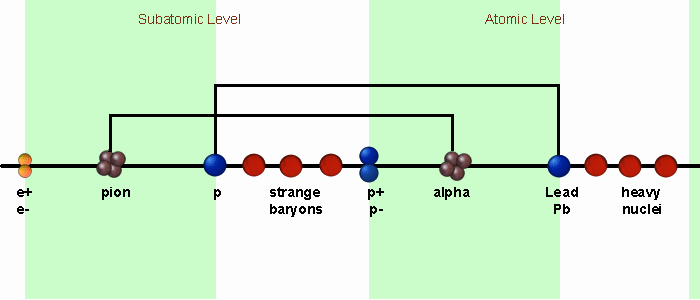| Here is what I see:
|
| There exists a set of subatomic particles, dubbed "strange baryons" that decay from one to the next with the emission of a particle called a pion. According to the quark theory, the heaviest of this set, the Omega minus, is composed of three strange quarks, and each time a pion is emitted, one unit of strangeness goes away, until the final product, the proton, is left and it has no strange quarks. Note that there is NO TANGIBLE FORM to the property of strangeness, but it was only conceived as a way to explain these decays. You might think that the pion carries away one unit of strangeness, but no, IT HAS NO STRANGENESS. Instead, they say that "strangeness is not conserved" in these decays. It simply disappears!
|
Omega Minus
Strangeness=3 |
 |
Pion
S=0 |
Xi
S=2 |
 |
Pion
S=0 |
Lambda
S=1 |
 |
Pion
S=0 |
Proton
S=0 |
 |
|
|
Compare those decays of so-called strange baryons to alpha radioactivity:
|
Omega Minus
Strangeness=3 |
 |
Pion
S=0 |
Xi
S=2 |
 |
Pion
S=0 |
Lambda
S=1 |
 |
Pion
S=0 |
Proton
S=0 |
 |
|
|
|
|
| Alpha |
 |
Uranium |
| Alpha |
 |
Thorium |
| Alpha |
 |
Radium
.
. |
| |
 |
.
.
Lead |
|
|
In alpha radioactivity a helium nucleus is emitted by a series of heavy nuclei as they decay from one to the next, until the stable element of lead is reached. The alpha particle may be described as being composed of "two sets of two oppositely-spinning fermions," meaning two protons and two neutrons. Fermions are matter-like particles, as opposed to wave-like particles called bosons.
|
| Proton |
 |
Proton |
| Neutron |
Neutron |
| Alpha Particle
|
|
|
Next consider the composition of the pion that is emitted in the "strange" decays. Its own decay products consist of:
- one electron
- one electron-type anti-neutrino
- one muon-type neutrino
- one muon-type anti-neutrino.
|
|
electron-type
Anti-neutrino |
 |
Electron |
muon-type
Anti-neutrino |
muon-type
Neutrino |
| Pion
|
|
|
| Proton |
 |
Proton |
| Neutron |
Neutron |
| Alpha Particle
|
|
|
|
Note that the pion may decay to a muon and an anti-neutrino as an intermediate step, but the ones listed are the FINAL decay products. Also note that neutrinos and antineutrinos have opposite spins.
|
Key point #1:
|
|
If you consider the electron to be a neutrino that happens to have electric charge, then the pion can be said to be composed of "two sets of two oppositely-spinning fermions" the same description that applies to alpha particles!
|
|
This is not a far-fetched supposition since the neutrino is known to substitute for an electron in any event as long as electric charge is conserved elsewhere.
|
Here are the clues that the pion is the subatomic equivalent of the alpha particle:
- The components of the pion "look" like those of an alpha particle, as described above
- Both pions and alpha particles are emitted in chains of decays of heavier particles
- Pions are known to bind nucleons together, and there is evidence that alpha particles are substructures of heavy nuclei
- Pions are the primary biproduct of proton-antiproton annihilations
- Pions don't just appear in the decays mentioned above; they are one of the most ubiquitous particles in the subatomic world
|
We now know that all nuclei are composed of protons and neutrons, but it was the identification of these as the constituents of an alpha particle that paved the way for our broader understanding.
|
Key point #2:
|
|
By extension, the neutrinos that make up the pion must also be the components of the nucleons.
|
|
Key point #3:
|
| If there were a particle that decayed to the Omega Minus with the emission of a pion the quark theory would never have developed the way it did because it would imply that this particle had four units of strangeness and the quark theory is all about thirds. However, there is no such particle, and I will tell you why:
|
| No Particle |
 |
| Omega |
 |
| Xi |
 |
| Lambda |
 |
| Proton |
 |
|
|
| P+ P- Pair |

 |
| Omega |
 |
| Xi |
 |
| Lambda |
 |
| Proton |
 |
|
|
|
The Omega Minus is the heaviest particle in that chain of decays because it has a mass just less than the mass of a proton-antiproton pair. If there were more energy available a proton-antiproton pair would be created.
|
|
|
Specifically the Omega Minus' mass is 1672 MeV and a proton-antiproton pair would "weigh" 1876 MeV. If you add the average mass difference between strange baryons to the mass of the Omega Minus, you exceed the mass of a proton-antiproton pair.
|
Here is another way of viewing what I've discussed so far:
|
|
|
I've linked the proton to the lead nucleus, and the pion to the alpha particle. The above image is from the middle of a sequence that I build up on my "granularity of matter" page. It links other subatomic particles to atomic ones, as well. Finish reading this page and then use the link at the bottom to go there.
|
| Visualization Aid:
|
| Imagine a collider that could be fine-tuned in the amount of energy released, and set it to the 1876 MeV required to make a proton-antiproton pair. Then that's exactly what you'd get. |
p+  p- p- |
|
|
| Now pretend you doubled the energy of the collision...you'd get two proton-antiproton pairs. |
p+  p- p-
p+  p- p- |
|
|
| But what if you throttled back halfway, to where you'd have three proton's worth of energy. Well, you can't make three protons, because they're baryons and can only be made with anti-baryons, so you'd have enough energy to make one pair and then you'd have some left over. What form can that take? Why pions, of course! Little subatomic alpha particles made of neutrinos! Some would stick with the protons to make strange baryons. Others might go flying off stuck to each other but without sticking to protons, and those would be kaons!
|
 
Omega Xi |
If you have read this far, you might be thinking that this is too simple to be right. I am telling you that this is too simple to be wrong!
|
|
|
Conclusion: |
|
If the electron was actually a charged neutrino, making the pion the subatomic form of alpha particle as I am suggesting, then the strange baryons are EXACTLY the sort of particles you would expect to be created when you had more energy available than one proton but less than a proton-antiproton pair.
|
|
|
For those of you who don't see why this is important, the strange baryons are the particles whose existence prompted quarks to be hypothesized. To explain their existence without quarks removes the need for quarks entirely.
|
|
Click here to see
the underlying granularity of matter.
 |











